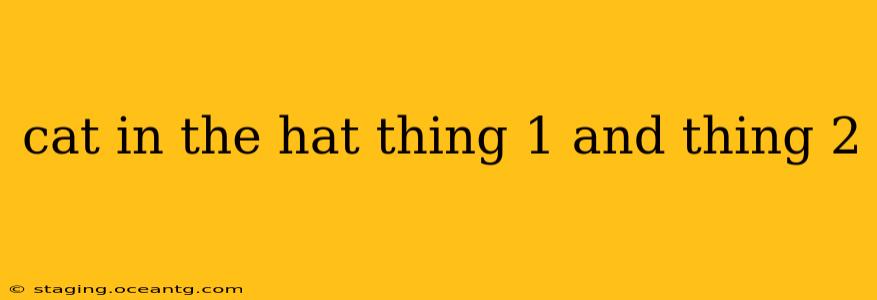Dr. Seuss's The Cat in the Hat is more than just a children's book; it's a cultural phenomenon. While the Cat himself is undeniably the star, the mischievous Thing 1 and Thing 2 are unforgettable characters who add a layer of chaotic energy to the story. Their antics, though nonsensical, have captivated readers for generations. This article delves into the enduring appeal of Thing 1 and Thing 2, exploring their origins, their impact on popular culture, and answering some frequently asked questions.
What are Thing 1 and Thing 2?
Thing 1 and Thing 2 are two mischievous, orange creatures with blue hair who accompany the Cat in the Hat in his chaotic visit to the home of Sally and her brother. They are essentially personifications of pure, unbridled fun and mayhem. Their actions are impulsive and nonsensical, defying logic and adult expectations of behavior. They are defined more by their energy and actions than by any concrete characteristics. The lack of distinct personalities beyond their shared playful destructiveness is part of their enduring charm. They represent the uninhibited joy and wild abandon often associated with childhood.
What is the significance of their names?
The simplicity of their names—Thing 1 and Thing 2—is part of their appeal. These labels highlight their lack of individual identity beyond their shared role as agents of chaos. They are not given individual names or backstories, emphasizing their status as embodiments of playful disruption. Their numbers suggest that they are interchangeable, highlighting the chaotic energy that defines their character. They are more like forces of nature than distinct individuals, mirroring the unpredictable nature of childhood.
Why are Thing 1 and Thing 2 so popular?
The enduring popularity of Thing 1 and Thing 2 stems from several factors:
- Their visual appeal: Their bright orange bodies and blue hair are instantly recognizable and visually striking, making them memorable characters for both children and adults.
- Their chaotic energy: Their playful destructiveness resonates with the inherent sense of mischief present in many children.
- Their ambiguity: Their lack of individual personalities allows readers to project their own interpretations onto the characters, making them relatable in a unique way.
- Their impact on popular culture: Thing 1 and Thing 2 have transcended the pages of the book, appearing in various adaptations, merchandise, and even inspiring countless fan art and interpretations.
What are Thing 1 and Thing 2's personalities?
While they lack distinct personalities in the traditional sense, we can infer some characteristics from their actions:
- Impulsive: Their actions are spontaneous and unplanned, driven by a desire for immediate gratification and fun.
- Playful: Their mischief is largely harmless, even if disruptive, suggesting a playful intent rather than maliciousness.
- Energetic: Their constant movement and chaotic behavior reflect an abundance of untamed energy.
- Interchangeable: Their identical appearances and similar actions reinforce the idea that they represent a single force of playful chaos rather than distinct individuals.
How do Thing 1 and Thing 2 contribute to the story's themes?
Thing 1 and Thing 2 are instrumental in highlighting the central themes of The Cat in the Hat:
- The allure of chaos: They embody the temptation of abandoning responsibility and embracing unrestrained fun.
- The importance of order and responsibility: Their eventual cleanup, although chaotic in its own way, underscores the need to restore order after a period of playful disruption.
- The complexities of childhood: They represent the unpredictable and sometimes overwhelming nature of children's energy and imagination.
The enduring legacy of Thing 1 and Thing 2 proves their significance within the Seuss universe and beyond. They are more than just sidekicks; they are symbols of untamed energy, playful mischief, and the enduring appeal of controlled chaos. Their simple yet effective character design and their contribution to the narrative's central themes have cemented their place in popular culture, ensuring their continued relevance for generations to come.
